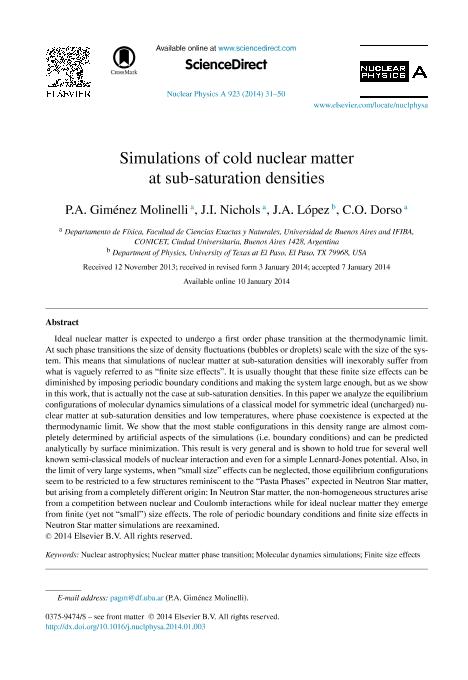Mostrar el registro sencillo del ítem
dc.contributor.author
Giménez Molinelli, Pedro Agustín

dc.contributor.author
Nichols, Juan Ignacio

dc.contributor.author
Lopez, J. A.
dc.contributor.author
Dorso, Claudio Oscar

dc.date.available
2017-12-28T21:33:22Z
dc.date.issued
2014-01
dc.identifier.citation
Dorso, Claudio Oscar; Lopez, J. A.; Nichols, Juan Ignacio; Giménez Molinelli, Pedro Agustín; Simulations of cold nuclear matter at sub-saturation densities; Elsevier Science; Nuclear Physics A; 923; 1-2014; 31-50
dc.identifier.issn
0375-9474
dc.identifier.uri
http://hdl.handle.net/11336/31911
dc.description.abstract
Ideal nuclear matter is expected to undergo a first order phase transition at the thermodynamic limit. At such phase transitions the size of density fluctuations (bubbles or droplets) scale with the size of the system. This means that simulations of nuclear matter at sub-saturation densities will inexorably suffer from what is vaguely referred to as “finite size effects”. It is usually thought that these finite size effects can be diminished by imposing periodic boundary conditions and making the system large enough, but as we show in this work, that is actually not the case at sub-saturation densities. In this paper we analyze the equilibrium configurations of molecular dynamics simulations of a classical model for symmetric ideal (uncharged) nuclear matter at sub-saturation densities and low temperatures, where phase coexistence is expected at the thermodynamic limit. We show that the most stable configurations in this density range are almost completely determined by artificial aspects of the simulations (i.e. boundary conditions) and can be predicted analytically by surface minimization. This result is very general and is shown to hold true for several well known semi-classical models of nuclear interaction and even for a simple Lennard-Jones potential. Also, in the limit of very large systems, when “small size” effects can be neglected, those equilibrium configurations seem to be restricted to a few structures reminiscent to the “Pasta Phases” expected in Neutron Star matter, but arising from a completely different origin: In Neutron Star matter, the non-homogeneous structures arise from a competition between nuclear and Coulomb interactions while for ideal nuclear matter they emerge from finite (yet not “small”) size effects. The role of periodic boundary conditions and finite size effects in Neutron Star matter simulations are reexamined.
dc.format
application/pdf
dc.language.iso
eng
dc.publisher
Elsevier Science

dc.rights
info:eu-repo/semantics/openAccess
dc.rights.uri
https://creativecommons.org/licenses/by-nc-nd/2.5/ar/
dc.subject
Astrofisica Nuclear
dc.subject
Transiciones de Fase
dc.subject
Dinamica Molecular
dc.subject.classification
Astronomía

dc.subject.classification
Ciencias Físicas

dc.subject.classification
CIENCIAS NATURALES Y EXACTAS

dc.title
Simulations of cold nuclear matter at sub-saturation densities
dc.type
info:eu-repo/semantics/article
dc.type
info:ar-repo/semantics/artículo
dc.type
info:eu-repo/semantics/publishedVersion
dc.date.updated
2017-12-12T18:52:36Z
dc.journal.volume
923
dc.journal.pagination
31-50
dc.journal.pais
Países Bajos

dc.journal.ciudad
Amsterdam
dc.description.fil
Fil: Giménez Molinelli, Pedro Agustín. Consejo Nacional de Investigaciones Científicas y Técnicas. Oficina de Coordinación Administrativa Ciudad Universitaria. Instituto de Física de Buenos Aires. Universidad de Buenos Aires. Facultad de Ciencias Exactas y Naturales. Instituto de Física de Buenos Aires; Argentina
dc.description.fil
Fil: Nichols, Juan Ignacio. Consejo Nacional de Investigaciones Científicas y Técnicas. Oficina de Coordinación Administrativa Ciudad Universitaria. Instituto de Física de Buenos Aires. Universidad de Buenos Aires. Facultad de Ciencias Exactas y Naturales. Instituto de Física de Buenos Aires; Argentina
dc.description.fil
Fil: Lopez, J. A.. University of Texas at El Paso; Estados Unidos
dc.description.fil
Fil: Dorso, Claudio Oscar. Consejo Nacional de Investigaciones Científicas y Técnicas. Oficina de Coordinación Administrativa Ciudad Universitaria. Instituto de Física de Buenos Aires. Universidad de Buenos Aires. Facultad de Ciencias Exactas y Naturales. Instituto de Física de Buenos Aires; Argentina
dc.journal.title
Nuclear Physics A

dc.relation.alternativeid
info:eu-repo/semantics/altIdentifier/url/http://www.sciencedirect.com/science/article/pii/S0375947414000049
dc.relation.alternativeid
info:eu-repo/semantics/altIdentifier/doi/http://dx.doi.org/10.1016/j.nuclphysa.2014.01.003
Archivos asociados
